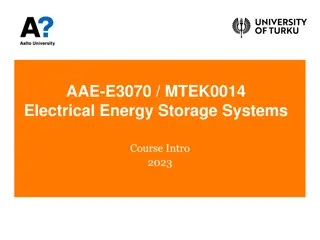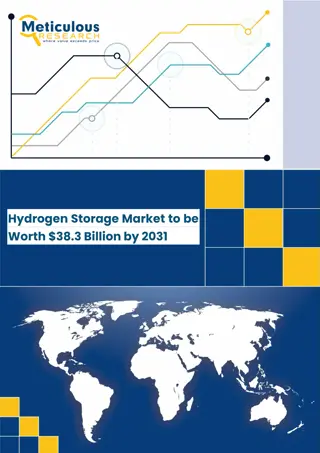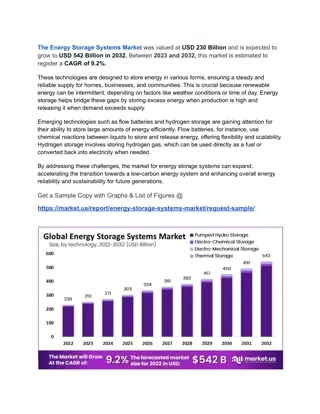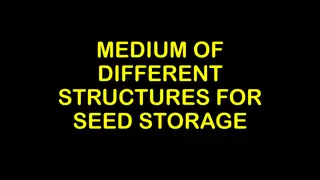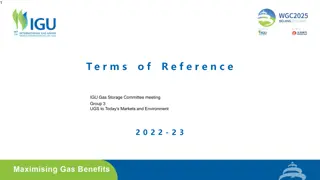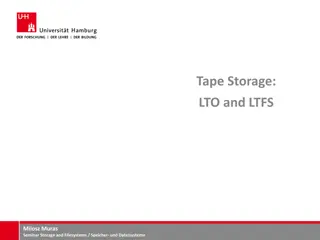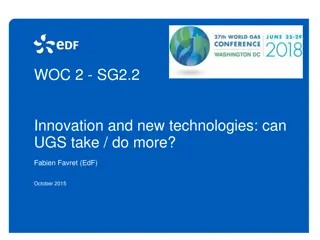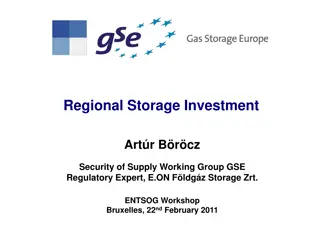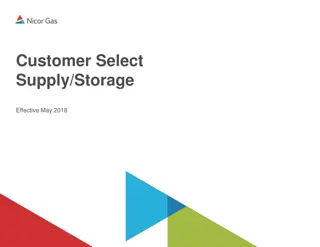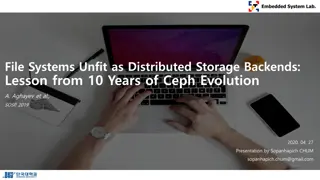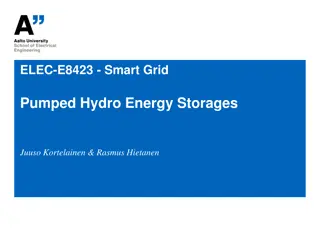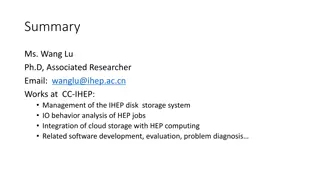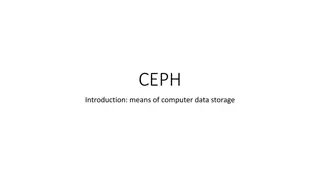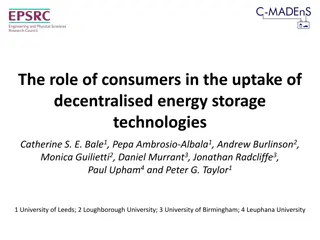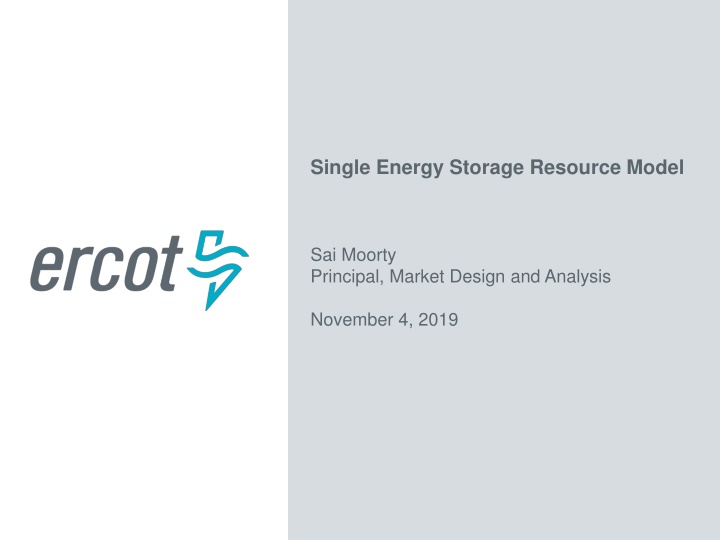
Characteristics of a Single Energy Storage Resource Model
This content outlines the key characteristics of a Single Energy Storage Resource (ESR) model in ERCOT market systems, focusing on state of charge management, operational constraints, telemetry responsibilities, and nodal price settlement for charging and discharging. It also discusses the implications for modeling and calculations in Real-Time, DAM, and RUC processes.
Download Presentation

Please find below an Image/Link to download the presentation.
The content on the website is provided AS IS for your information and personal use only. It may not be sold, licensed, or shared on other websites without obtaining consent from the author. If you encounter any issues during the download, it is possible that the publisher has removed the file from their server.
You are allowed to download the files provided on this website for personal or commercial use, subject to the condition that they are used lawfully. All files are the property of their respective owners.
The content on the website is provided AS IS for your information and personal use only. It may not be sold, licensed, or shared on other websites without obtaining consent from the author.
E N D
Presentation Transcript
Single Energy Storage Resource Model Sai Moorty Principal, Market Design and Analysis November 4, 2019
Characteristics of a Single Model ESR (Phase 1) ERCOT market systems will not consider State of Charge (SOC) related telemetry No State of Charge Management in DAM, RUC, Real-Time market SOC related telemetry by QSE will be used for: PRC calculation To increase situational awareness Physically a single device with one electrical pathway to the modeled electrical network The charging and discharging electrical path is the same Limited energy storage capability (<= 24 hours). This implies that the ESR cannot discharge continuously at its rated MW for 24 hours. Does not have temporal constraints (StartTime, MinUpTime, MinDownTime, etc.) and does not have transition times between charging and discharging Does not have startup, shutdown and transition costs Can smoothly transition from charging to discharging and vice-versa and there is no dead band around 0 MW All data inputs are measured at the Point of Interconnection (POI) or Point of Common Coupling (PCC) Single price curve from charging (Bid-To-Buy) to discharging (Offer-To-Sell) that is monotonically non-decreasing as the MW quantity increases; i.e., the single submitted price curve covers both the charging and discharging MW range 2 ERCOT Public
Characteristics of a Single Model ESR ESR Status will be ON, ONXX, OFF, or OUT. This statement reflects current thinking that new statuses are NOT required With the above characteristics, MMS modeling/calculations for ESRs become a dispatch problem for Real-Time (SCED), DAM and RUC processes. An ESR will be settled at a Nodal price for both charging and discharging. QSE responsible for maintaining state of charge (MWh) and reflecting energy capability to ERCOT via telemetry, COP, etc. 3 ERCOT Public
Single Model ESR QSE responsibility for managing State of Charge by changing ESR (HSL,LSL) telemetry ESR Telemetry 10MW HSL Resource Status (ON,OFF,OUT ,etc.) Breaker MW=BP+AS Deployed Gross MW Meter 0 MW Gross MVAr Resource Node Net MW ESR Net MVar + - HSL ESR LSL (can be negative) LSL (can be negative) ESR State Of Charge (SOC) Telemetry -10MW SOC (MWHr) MaxLimitSOC (MWHr) MinLimitSOC (MWHr) Empty Full MaxDisRate (MW) MWHr MaxChgRate (MW) 4 ERCOT Public
Combo Model Enhancements Applicable to Single Model ESR Improvements to the use of the Combo model in current systems will be incorporated, if applicable: PRC Calculation considering State of Charge (RTOLCAP calc. changes does not carry over when RTC goes live) Mitigation changes Allowing updates to EOC closer to Real-Time Applicable changes to RUC to consider limited energy storage capacity of Storage Resources Nodal price settlement for both charging and discharging, regardless of whether Storage Resource has WSL treatment RTC will dispatch a Single Model ESR on its nodal shift factor Reactive Capability (4 quadrant) and Voltage Support Service Voltage/Frequency Ride-through requirements Uniform Governor Deadband and Droop setting requirements from charging to discharging Energy Storage Resource Performance Deployment (ESRDP) 5 ERCOT Public
Single Model ESR : Three Part Supply Offer (3PO) For Single model ESR, submitted 3PO must have NULL for startup and Minimum Energy Costs Single model ESR does not have: Startup Costs (Hot, Intermediate, Cold) Minimum Energy Cost Energy Offer Curve Single Cost curve shall be monotonically increasing from maximum charging MW (negative) to maximum discharging MW. The maximum price on the charging curve is less than the minimum price on the discharging curve i.e. ? > 0 10 quantity, price pairs to represent linear cost curve 6 ERCOT Public
Single Model ESR : Energy Incremental Cost Curve Single Cost curve shall be monotonically increasing from maximum charging MW (negative) to maximum discharging MW. The maximum price on the charging curve is less than the minimum price on the discharging curve i.e. ? > 0 Single ESR Model Combo ESR Model $/MWh $/MWh $100/MWh $100/MWh ESR-GR EOC ? > 0 $4/MWh Discharging MW (+ve) Discharging MW (+ve) Charging MW (-ve) $/MWh ESR-CLR RTM Bid $4/MWh Charging MW (+ve) 7 ERCOT Public
Single Model ESR : AS Participation Matrix RegUp Conventional RegDn Conventional RRS PFR ECRS Dispatchable NSPIN FRRSUp FRRSDn UFR FFR Blocky X X X X X X X X Single Device Storage Resource Note any Resource must pass AS product specific qualification process to be eligible to provide that AS product No Change to AS Offer structure 8 ERCOT Public
Single ESR Model Statuses Resource Status COP Telemetry Proposed use of Generation Resource Status under RTC Available for energy and AS awards Considered to be same as ON Y Y Y Y ON ONOPTOUT Y Y Considered to be same as ON (specific rules for EOC and AS Offer) ONRUC Y Y Applying current rules for output schedules, available for energy and AS awards Considered to be same as ON for energy, ECRS and NSPIN. Cannot be awarded Regulation or Responsive Reserve Not available to for energy, RegUp, RegDn, RRS, or ECRS awards Available for NSPIN if qualified Energy participation same as today. Not eligible for AS award ONOS Y Y OFFQS Y Y OFF Y Y ONTEST Y Y Considered to be same as ON,Not eligible for AS award QSE may appropriately set LSL and HSL to reflect operating limits Not available for energy or AS awards Not available for energy or AS awards Not available for energy or AS awards ONEMR Y Y Y Y Y Y OUT EMR EMRSWGR 9 ERCOT Public
COP: Single Model ESR For a Single Model ESR, follows the proposals for the Combo model of ESR: HSL reflects duration limitation LSL, which can be negative, will also reflect duration limitation HSL-LSL must be greater than or equal to the total AS capability of the single model ESR 10 ERCOT Public
DAM: Single Model ESR In DAM, for a Single Model ESR: If Three Part Supply Offer for energy or AS Offer exists, then Single Model ESR is considered to be self-committed, i.e. On-Line No temporal constraints, there is no StartTime, Minimum Up time, Minimum Down Time, Transition Time, etc. DAM modeling/calculations for Single Model ESRs becomes a dispatch problem to solve 11 ERCOT Public
RUC: Single Model ESR Single Model ESR will not be RUCed . In the RUC engine, for a Single Model ESR: Single Model ESR with COP status of OFF or ONXX, is considered to be self- committed, i.e. On-Line No temporal constraints, there is no StartTime, Minimum Up time, Minimum Down Time, Transition Time, etc. RUC modeling/calculations for Single Model ESRs becomes a dispatch problem to solve. RUC will use as cost curve: Cost Curve of ESR discharge MW (generation) is SWCAP (MOC proposal for ESR) Cost Curve of ESR charge MW (consumption) is $-251/MWh (system wide price floor) Minimizes use of ESR to serve energy 12 ERCOT Public
RTC: Constraints for On-Line Single ESR Model 1. Dispatch Limits, note LSL,LDL can be negative ???? ???? ???????? ???? ???? ????= ??? ????, ????????+ ?????? 5 ????= ??? ????, ???????? ?????? 5 HSL LSL LDL TelemMW HDL Can be negative 2. As Awards (by type) for On-Line ESR will be limited by qualification amount for a give AS-type and telemetered max capability 13 ERCOT Public
RTC: Constraints for On-Line Single ESR Model 3. LDL/LSL constraint: Ensures that the energy (Base Point) and Regulation Down awards are feasible with respect to the LDL and LSL of the Resource ??????????? ??????????????? ??? ??????????+ ??? ??????????? ??? ???? 0 ??????????? ??? ??????????+ ??? ??????????? ???? 0 ??? ????= ??? ????, ???????? ?????? 5 ??????????+ ??? ??????????? ??? HSL LSL LDL HDL ??????????? ??? Energy awards can be positive or negative AS awards are positive 14 ERCOT Public
RTC: Constraints for On-Line Single ESR Model 4. HDL constraint: Ensures that the energy (Base Point) and Regulation Up awards are feasible with respect to the HDL of the Resource ??????????? ??????????????? ??????????+ ??? ???? ??? ??? ??????????? 0 ??????????+ ??? ??????????? ??? HSL LSL LDL HDL ??????????? ??? Energy awards can be positive or negative AS awards are positive 15 ERCOT Public
RTC: Constraints for On-Line Single ESR Model 5. HSL constraint: Ensures that the energy (Base Point), Regulation Up, Responsive Reserve (PFR, FFR), ECRS and On-line NSPIN awards are feasible with respect to the High Sustained Limit (HSL) of the Resource ??????????? ??? ???????? ??? ?????????? ??? ????????? ??? ??????????? ??? ?????????? 0 ???????? ???? ??? ??? ??????????+ ??? ??????????? ??? ????????+ ??? ???????? ??? HSL LSL LDL HDL ??????????? ??? ???????? ??? ?????????? ??? Energy awards can be positive or negative AS awards are positive 16 ERCOT Public
Discussion ERCOT Public


